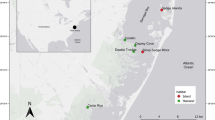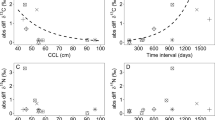Abstract
During migrations and ontogeny amphibians change their habitat and feeding, and thus are important in linking terrestrial and aquatic ecosystems. We measured δ 13C and δ 15N values of early stages (egg, embryo, tadpole) and toes of adult frogs Rana temporaria, collected from a small wetland in Lithuania. We compared the isotopic composition of these tissues with potential food sources, excrements of tadpoles, and filled intestinal tracts. We found that δ 13C values in R. temporaria tadpoles were markedly depleted in comparison to adults, eggs or embryos, demonstrating a terrestrial to aquatic shift in energy sources. After the onset of feeding, tadpoles approached isotopic equilibrium with available food (algae and litter). Tadpoles had higher δ 15N than both algae and litter, differing by 3.6 and 2.4‰, respectively, and similar δ 13C to these sources. However, tadpole excrements and body tissue diverged, with mean δ 13C values of excrements (−30.3 ± 1.6‰ SD) more similar to litter (−31.7 ± 1.2‰ SD) and body tissue δ 13C (−34.8 ± 0.7‰ SD) more similar to algae (−34.2 ± 4.1‰ SD). This suggests that algal resources are critical in early life stages of this anuran, particularly at stages characterized by high growth and low development (stages: 25–35).


Similar content being viewed by others
References
Alford, R. A. & G. D. Jackson, 1993. Do Cephalopods and larvae of other taxa grow asymptotically. American Naturalist 141: 717–728.
Altig, R., M. R. Whiles & C. L. Taylor, 2007. What do tadpoles really eat? Assessing the trophic status of an understudied and imperiled group of consumers in freshwater habitats. Freshwater Biology 52: 386–395.
Alvarez, D. & A. G. Nicieza, 2002. Effects of temperature and food quality on anuran larval growth and metamorphosis. Functional Ecology 16: 640–648.
Anholt, B. R. & E. E. Werner, 1998. Predictable changes in predation mortality as a consequence of changes in food availability and predation risk. Evolutionary Ecology 12: 729–738.
Arnold, E. N. & D. W. Ovenden, 2002. Reptiles and Amphibians of Europe. Princeton University Press, Princeton, Oxford.
Banks, B. & T. J. C. Beebee, 1987. Spawn predation and larval growth inhibition as mechanisms for niche separation in anurans. Oecologia 72: 569–573.
Bowen, S. H., 1987. Composition and nutritional value of detritus. In Moriarty, D. J. W. & R. S. V. Pullin (eds), Detritus and Microbial Ecology in Aquaculture. International Center for Living Aquatic Resources Management, Manila: 192–216.
Brett, M. T., M. J. Kainz, S. J. Taipale & H. Seshan, 2009. Phytoplankton, not allochthonous carbon, sustains herbivorous zooplankton production. Proceedings of the National Academy of Sciences of the United States of America 106: 21197–21201.
Bunn, S. E., P. M. Davies & M. Winning, 2003. Sources of organic carbon supporting the food web of an arid zone floodplain river. Freshwater Biology 48: 619–635.
Cole, J. J., S. R. Carpenter, J. F. Kitchell, M. L. Pace, C. T. Solomon & B. C. Weidel, 2011. Strong evidence for terrestrial support of zooplankton in small lakes based on stable isotopes of carbon, nitrogen, and hydrogen. Proceedings of the National Academy of Sciences of the United States of America 108: 1975–1980.
Collier, K. J., S. Bury & M. Gibbs, 2002. A stable isotope study of linkages between stream and terrestrial food webs through spider predation. Freshwater Biology 47: 1651–1659.
Dalerum, F. & A. Angerbjorn, 2005. Resolving temporal variation in vertebrate diets using naturally occurring stable isotopes. Oecologia 144: 647–658.
Elser, J. J., W. F. Fagan, R. F. Denno, D. R. Dobberfuhl, A. Folarin, A. Huberty, S. Interlandi, S. S. Kilham, E. McCauley, K. L. Schulz, E. H. Siemann & R. W. Sterner, 2000. Nutritional constraints in terrestrial and freshwater food webs. Nature 408: 578–580.
Finlay, J. C., 2001. Stable-carbon-isotope ratios of river biota: implications for energy flow in lotic food webs. Ecology 82: 1052–1064.
Fry, B., 2006. Stable Isotope Ecology. Springer, New York.
Gosner, K. L., 1960. A simplified table for staging anuran embryos and larvae with notes on identification. Herpetologica 16: 183–190.
Houlahan, J. E., C. S. Findlay, B. R. Schmidt, A. H. Meyer & S. L. Kuzmin, 2000. Quantitative evidence for global amphibian population declines. Nature 404: 752–755.
Houston, W. W. K., 1973. The food of the common frog, Rana temporaria, on high moorland in northern England. Journal of Zoology 171: 153–165.
Iwai, N. & T. Kagaya, 2005. Difference in larval food habit of two Japanese Rana species. Journal of Freshwater Ecology 20: 765–770.
Jardine, T. D., D. L. MacLatchy, W. L. Fairchild, R. A. Cunjak & S. B. Brown, 2004. Rapid carbon turnover during growth of Atlantic salmon (Salmo salar) smolts in sea water, and evidence for reduced food consumption by growth-stunts. Hydrobiologia 527: 63–75.
Jardine, T. D., R. A. Curry, K. S. Heard & R. A. Cunjak, 2005. High fidelity: Isotopic relationship between stream invertebrates and their stomach contents. Journal of the North American Benthological Society 24: 290–299.
Jardine, T. D., K. A. Kidd & A. T. Fisk, 2006. Applications, considerations, and sources of uncertainty when using stable isotope analysis in ecotoxicology. Environmental Science & Technology 40: 7501–7511.
Jardine, T. D., E. Chernoff & R. A. Curry, 2008. Maternal transfer of carbon and nitrogen to progeny of sea-run and resident brook trout (Salvelinus fontinalis). Canadian Journal of Fisheries and Aquatic Sciences 65: 2201–2210.
Jefferson, D. M. & R. W. Russell, 2008. Ontogenetic and fertilizer effects on stable isotopes in the green frog (Rana clamitans). Applied Herpetology 5: 189–196.
Jenssen, T. A., 1967. Food habits of the green frog, Rana clamitans, before and during metamorphosis. Copeia 1967: 214–218.
Kam, Y. C., C. S. Wang & Y. S. Lin, 1995. Reproduction and diet of the brown frog Rana longicrus in Taiwan. Zoological Studies 34: 193–201.
Karr, J. D., W. J. Showers, J. W. Gilliam & A. S. Andres, 2001. Tracing nitrate transport and environmental impact from intensive swine farming using delta nitrogen-15. Journal of Environmental Quality 30: 1163–1175.
Kelly, M. H., W. G. Hagar, T. D. Jardine & R. A. Cunjak, 2006. Nonlethal sampling of sunfish and slimy sculpin for stable isotope analysis: how scale and fin tissue compare with muscle tissue. North American Journal of Fisheries Management 26: 921–925.
Lardner, B. & J. Loman, 1995. Predation on Rana and Bufo tadpoles: predator species and tadpole size effects. Memoranda Societatis pro Fauna et Flora Fennica 71: 149.
Logan, J. M., T. D. Jardine, T. J. Miller, S. E. Bunn, R. A. Cunjak & M. E. Lutcavage, 2008. Lipid corrections in carbon and nitrogen stable isotope analyses: comparison of chemical extraction and modelling methods. Journal of Animal Ecology 77: 838–846.
Loman, J., 2009. Primary and secondary phenology. Does it pay a frog to spawn early? Journal of Zoology 279: 64–70.
Loman, J. & B. Lardner, 2009. Density dependent growth in adult brown frogs Rana arvalis and Rana temporaria—a field experiment. Acta Oecologica 35: 824–830.
McDiarmid, R. W. & R. Altig, 1999. Tadpoles: The Biology of Anuran Larvae. The University of Chicago Press, Chicago, London.
Minagawa, M. & E. Wada, 1984. Stepwise enrichment of 15N along food chains: further evidence and the relation between δ15N and animal age. Geochimica Cosmochimica Acta 48: 1135–1140.
Moore, J. C., E. L. Berlow, D. C. Coleman, P. C. de Ruiter, Q. Dong, A. Hastings, N. Collins Johnson, K. S. McCann, K. Melville, P. J. Morin, K. Nadelhoffer, A. D. Rosemond, D. M. Post, J. L. Sabo, K. M. Scow, M. J. Vanni & D. H. Wall, 2004. Detritus, trophic dynamics and biodiversity. Ecology Letters 7: 584–600.
Oertli, B., 1993. Leaf-litter processing and energy-flow through macroinvertebrates in a woodland pond (Switzerland). Oecologia 96: 466–477.
Peterson, B. J. & B. Fry, 1987. Stable isotopes in ecosystem studies. Annual Review of Ecology and Systematics 18: 293–320.
Pieczynska, E., 1986. Sources and fate of detritus in the shore zone of lakes. Aquatic Botany 25: 153–166.
Ponsard, S. & R. Arditi, 2000. What can stable isotopes (δ15N and δ13C) tell us about the food web of soil macro-invertebrates? Ecology 81: 852–864.
Post, D. M., 2002. Using stable isotopes to estimate trophic position: models, methods and assumptions. Ecology 83: 703–718.
Post, D. M., C. A. Layman, D. A. Arrington, G. Takimoto, J. Quattrochi & C. G. Montana, 2007. Getting to the fat of the matter: models, methods and assumptions for dealing with lipids in stable isotope analyses. Oecologia 152: 179–189.
Rau, G. H., 1980. Carbon-13/carbon-12 variation in subalpine lake aquatic insects: food source implications. Canadian Journal of Fisheries and Aquatic Sciences 37: 742–746.
Regester, K. J., K. R. Lips & M. R. Whiles, 2006. Energy flow and subsidies associated with the complex life cycle of ambystomatid salamanders in ponds and adjacent forest in southern Illinois. Oecologia 147: 303–314.
Savage, R. M., 1961. The ecology and life history of the common frog. Isaac Pitman, London.
Seale, D., 1980. Influence of amphibian larvae on primary production, nutrient flux, and competition in a pond ecosystem. Ecology 61: 1531–1550.
Siegel, S. & N. J. Castellan, 1988. Nonparametric Statistics for the Behavioral Sciences, 2nd ed. McGraw-Hill, New York.
Verburg, P., S. S. Kilham, C. M. Pringle, K. R. Lips & D. L. Drake, 2007. A stable isotope study of a neotropical stream food web prior to the extirpation of its large amphibian community. Journal of Tropical Ecology 23: 643–651.
Walters, D. M., K. M. Fritz & R. R. Otter, 2008. The dark side of subsidies: adult stream insects export organic contaminants to riparian predators. Ecological Applications 18: 1835–1841.
Whiles, M. R., K. R. Lips, C. M. Pringle, S. S. Kilham, R. J. Bixby, R. Brenes, S. Connelly, J. C. Colon-Gaud, M. Hunte-Brown, A. D. Huryn, C. Montgomery & S. Peterson, 2006. The effects of amphibian population declines on the structure and function of Neotropical stream ecosystems. Frontiers in Ecology and the Environment 4: 27–34.
Zahn, A., 1997. Hinweise zur Prädation von Froschlurchlarven durch Molche [Triturus alpestris and T. vulgaris as predators of anuran larvae]. Salamandra 33: 89–91.
Acknowledgments
We thank Rasa Gvozdaitė for assistance in the lab, Jolanta Kostkevičienė for identifying algae, and Laura Jardine for providing helpful comments on the manuscript. This research was partially supported through a Vilnius University research program (Ecosystems’ and Climate Changes, Preservation of Environment and Use of Natural Resources) to Giedrius Trakimas.
Author information
Authors and Affiliations
Corresponding author
Additional information
Handling editor: Lee B. Kats
Rights and permissions
About this article
Cite this article
Trakimas, G., Jardine, T.D., Barisevičiūtė, R. et al. Ontogenetic dietary shifts in European common frog (Rana temporaria) revealed by stable isotopes. Hydrobiologia 675, 87–95 (2011). https://doi.org/10.1007/s10750-011-0804-3
Received:
Revised:
Accepted:
Published:
Issue Date:
DOI: https://doi.org/10.1007/s10750-011-0804-3




